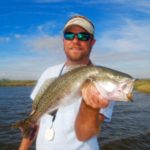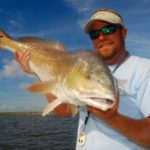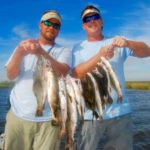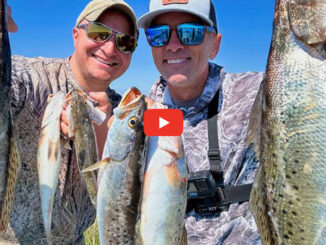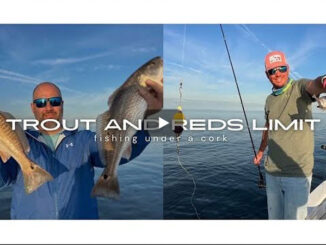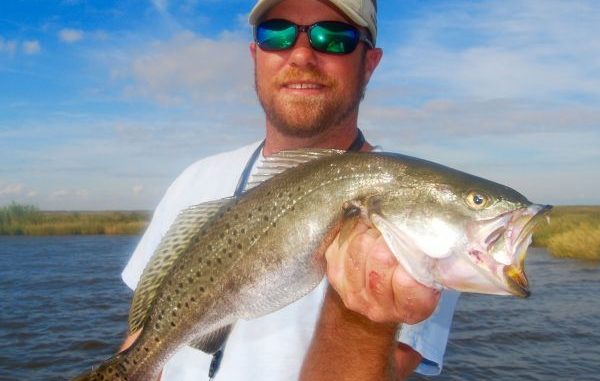
Live shrimp is key — especially this time of year, Laboureur says
Transitioning speckled trout are on the proverbial doorstep at Shell Beach, but they haven’t quite yet come on in and committed to interior marshes, according to a local fishing guide.
Capt. Jakamo Laboureur, with Jakamo South Fishing Adventures, said he’s already had some success fishing inside this month, but the early stages of the transition have been inconsistent so far.
“If we have a few more fronts, I’m definitely thinking they’ll move inside,” he said. “Early last week, I caught them close in Lake Robin — boom, boom boom. We did excellent, and I thought it was going to be on.
“Then we had some warmer weather, and a lack of tide for a few days, which kind of pushes us back outside where we at least have a little trickle of water.”
On a trip last Thursday — where tidal movement was less than a foot — I went on a trip with Laboureur and his friend Eric Olsen, and we put 75 specks in the box, with very few throwbacks. But most of the damage we did was concentrated around Stone Island in Black Bay, and the leeward shorelines of the islands in Bay LaFourche.
“Moving water is the key to the process, and the water temperatures warmed up,” he said. “Early last week it was 69 degrees. On our trip it was about 74.
“We’re only talking about a couple of degrees, but that can really change things for the fish.”
If you’re planning a trip to Shell Beach before the transition really kicks in — which should be later this month — Laboureur said to focus on bodies of water along the outer edges of the interior marshes, like Black Bay, Lake Campo, Oak River Bay, Bay LaFourche and Bay Gardene.
“I’m working points, pockets, oyster reefs or spots with a hard bottom,” Laboureur said. “Wherever the water is pushing through with a good hard bottom structure, that’s what I’m doing.
“When you’re driving into a spot and hear your prop hitting shells, or if you’re fishing an island and see white shells on the island, that means more than likely there’s a bunch of shells in the water right there that have been pushed up from hurricanes. Typically it will be the eastern part of the island, because southeast is our prevailing wind.”
Laboureur’s Top 3 tips to fish for speckled trout out of Shell Beach in October are:
1. Fish with live shrimp.
“Campo’s live shrimp under a cork is the key,” he said. “They’re 30 cents a piece, but they’re very generous with their count.
“When you’re trying to do what I’m trying to do — which is to catch 75, 100 or 125 trout on a trip — you need all the odds in your favor.”
Laboureur uses a No. 1 kahle hook a couple feet under a popping cork, and doesn’t care if they are hooked through the horn, the tail or in the middle.
“Shrimp will help you find them faster and keep them there,” he said. “I can take a handful of shrimp and throw them out there to keep the bite going. We’ll chum with live shrimp.”
If you’re set on fishing with plastics, he recommended the Berkley Gulp 3-inch swimming mullet (with the curly tail) in white, glow, chartreuse or pink.
2. Look for diving birds.
“They’re going to be feeding on the shrimp,” he said. “If you see the birds and see the bait, check it out and fish it.”
And expect to bounce around a bit to fill the box, especially early in the transition.
“But if you catch a few in one area, work that area. Don’t think you have to run 10 miles to your other spot. I’ll see people that go in, fish, catch a few fish and then leave when the bite dies. They say, ‘Oh well, that was my spot and they’re not here. Let me go someplace else.’ Then they zig-zag and go someplace far away.
“Well, if you picked up 20 fish there, maybe scoot down the shoreline a little bit. Move to the next point. See where they have some current or shelves or reefs around there to fish.”
3. Check the tides.
Being on the water first thing in the morning is more important in the summer than it is in the fall, Laboureur said.
“If you have a high tide at like 7:30 or 9 in the morning, there’s no sense in leaving when the tide is not moving. You don’t need to worry about a morning bite as much — you need that moving water.
“So instead of wasting your time for three hours in the morning burning gas and going through your spots, wait a little bit and hit your spots when the water is moving. You’ll save yourself a lot of time and effort.”
